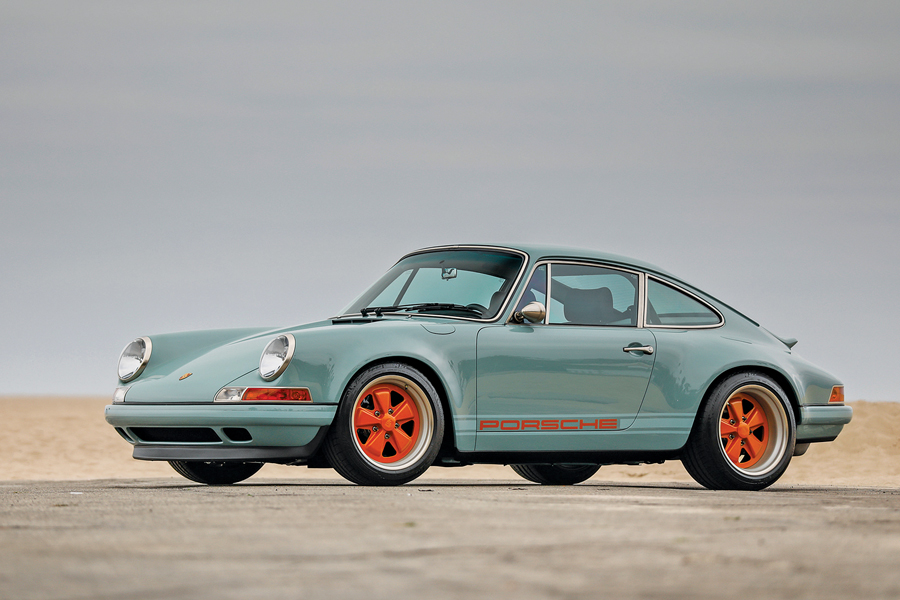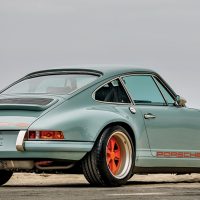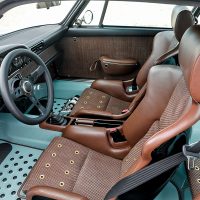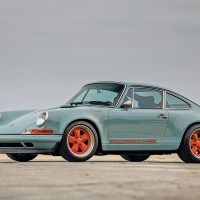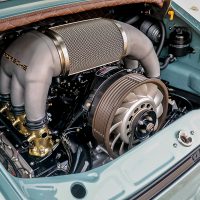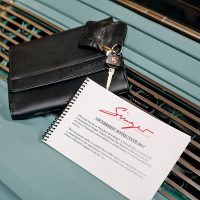- The first Singer-reimagined 911 offered at auction
- Completed in 2016 and known as the “Mountain View Car”
- Lightweight specification inspired by classic sports-purpose models
- Stunning Downton Blue and Singer Racing Orange livery
- Extraordinary attention to detail throughout
SCM Analysis
Detailing
| Vehicle: | 1991 Porsche 964 “Reimagined by Singer” |
| Years Produced: | 2010–ongoing |
| Number Produced: | 140 (to date) |
| Original List Price: | $465,000 (estimated) |
| SCM Valuation: | $857,500 (this car) |
| Tune Up Cost: | $2,000 with wires, cap and valve adjustment |
| Chassis Number Location: | 964 chassis number on lip behind spare-tire well, on inner passenger’s side fender, on label at base of driver’s side windshield |
| Engine Number Location: | On engine case boss under the fan, reading vertically, facing to the right |
| Club Info: | Porsche Club of America |
| Website: | http://www.pca.org |
| Alternatives: | 1987–92 Ruf CTR, 2004–05 Porsche Carrera GT, 2011 Porsche 997 GT3 RS 4.0-liter |
| Investment Grade: | B |
This car, Lot 14, sold for $857,500, including buyer’s premium, at Gooding & Company’s Pebble Beach, CA, auction on August 16, 2019.
Rob Dickinson created a brand name in the resto-mod Porsche 911 market after he started his business in Sun Valley, CA, in 2010. There are two stories behind the name: First, it’s a salute to Porsche’s engineering legend, Norbert Singer; second, it’s a nod to Dickinson’s previous role as lead singer and guitarist for the British alternative rock band Catherine Wheel, active from 1990 to 2000 — remember “Waydown”?
Trademarks and outlaws
Out of respect for Porsche AG’s legal department, Singer specifies that these cars are “restored, reimagined and reborn” Porsches, thus the moniker “Porsche 911 Reimagined by Singer.” That said, we all know what the cars are called in our world. With marketing savvy and laser focus on the details, Singer’s reimagined 911s have become iconic.
The roots for Singer’s work lie in the hundreds of 911 Outlaws that have been around for decades. Their values, even for the very best builds, have never approached the list prices of the Singer-modified 911s. How did these cars get to their lofty level? It all started with a 1969 911E.
Dickinson migrated to Southern California after the millennium and built an outlaw 911 for himself. It was a Bahama Yellow 1969 911E, well modified in 1967–68 911R lightweight fashion. Dickinson got numerous offers for it. The transition to restoring 911s for customers was slow, but the concept was well conceived.
For a base car, Dickinson chose the 1989–94 Porsche 911 (Type 964) — the first street 911s that forsook torsion bars for coil-over suspensions. Singer retrofitted the cars back to 1964–73 long-hood appearance but with carbon-fiber hoods, engine lids, spoilers, fenders and roofs.
Not only were 964s readily available, in that day they also were substantially less expensive than 930s or 993s. That pricing disparity has been reduced, largely because of Singer and 964-modifying imitators.
From 12 to 140 in five years
By 2013, Singer had “processed” about a dozen cars, with prices that started at $350,000. Following positive publicity, the business grew. By 2015, press reports put Singer’s sales at 30 cars with a backlog of 40 orders, and prices started at $390,000. Currently, Singer reports 140 cars completed and a like number in the pipeline, representing more than two years of deliveries.
Although Singer sometimes restores exteriors in standard colors, paint jobs often have been subtle grays, blues and greens with contrasting stripes — usually orange. Denoting some proprietary design intent, the tachometer faces were always orange. With ubiquitous nickel-plated trim, through-the-hood gas fillers, 1967–68 911R-model right rear fender external oil fillers, wide flared fenders and frosted-edge 17-inch Fuchs wheels, the Singer “look” was readily identifiable.
“Everything is important”
Another Singer characteristic was reflected in the firm’s mantra, “Everything is important.” Almost all the cars’ details were re-engineered. For example, because Dickinson disliked the appearance of screw heads on the taillights, he had completely new ones manufactured that used modern glues — no screws. The rear-view mirrors are unique units that go through the quarter-window glass. The dash is covered in precise basket-weave leather. All of the controls are modified for an exclusive, even heavier feel — well, except the snick-snick 6-speed Getrag gearbox. A virtual ecosystem of suppliers contribute to Singer’s “reimagining,” with more than 4,000 hours of work going into each car.
The engines available now are all produced by Ed Pink Racing Engines in Van Nuys, CA. Initially, Singer used 3.6-liter units, added a 3.8 and then a 4.0. The buyer has a choice with a price tag to match. EPRE takes in the 964 donor engines and uses only the cases, cam towers and chain boxes. Everything else is new and carefully mated with attention to tolerances. EPRE uses Motec engine management systems.
An evolution called the “Dynamics and Lightweighting Study” was introduced in 2018 at Goodwood. It specifies a 500-horsepower, 4-valve-per-cylinder, normally aspirated 4.0-liter engine, and advanced aerodynamics — all developed in collaboration with Williams Advanced Engineering (yup, the Formula One folks). Also included is unique full-carbon bodywork with add-on flares reminiscent of a Porsche 934, center-lock 18-inch magnesium wheels by BBS, Bosch ABS, traction control, electronic stability control, special tires by Michelin, and a lightweight 6-speed Hewland gearbox. Singer will sell up to 75 such cars, with prices starting at $1,800,000.
An unusual specification for this car
The first Singer project to make it to public auction was this Downton Blue example with orange trim, consigned to Gooding & Company’s Monterey sale in August. It was known as the Mountain View (CA) car and was originally ordered to a very lightweight specification: no radio, no sunroof, no a/c and with other lightweight touches. The buyer also ordered unique carbon-fiber seats, trimmed in dark brown leather — reportedly for $30,000 extra. It resulted in a car that weighed less than 3,000 pounds.
This car had an early Ed Pink 4.0-liter, originally in California smog specs at 350 horsepower, with a Getrag 6-speed, Brembo brakes and Ohlin shocks. Later, the engine was de-smogged to deliver 390 horsepower.
The buyer was a friend of mine who collects the lightest, lowest-mileage, most-original Porsches he can find. He reported that he liked driving the car — 2,000 miles’ worth between 2016 and 2018 — but decided the car did not fit in his large collection of bespoke Porsches. He traded it against a special 959 with another friend in the northern Midwest. The car also did not fit well in his collection of low-mileage, original, low-production Porsches with a preference for unusual colors. Thus, he consigned the car to Gooding.
Protecting the aftermarket
Singer has been smart in brokering their own cars, in large part because owners who want to sell usually call Singer. A car trading in public at a low price would diminish the perceived value of both old and new restorations.
I have two other friends who, in the past nine months, have resold their cars through Singer — an older 3.6 for $675,000 and a very low-miles 3.8 for $700,000. At the time of this auction, there was only one other Singer for public sale, and it was in the U.K. It was Midnight Blue with 14,000 km and the asking price was the equivalent of $845,000. The availability of Singer restorations has always been thin.
At auction, there reportedly was an absentee bid on Gooding’s books for over $700,000. Was that Singer? It’s certainly possible. Nonetheless, Singer had no worries. Action in the room was fast, thanks in part to the absentee bid, and the car hammered at $775,000 to a nice-guy New York City investment banker for an all-in of $857,500.
That’s full money, but buying this car probably beat waiting two years to get a new one. ♦
(Introductory description courtesy of Gooding & Company.)
